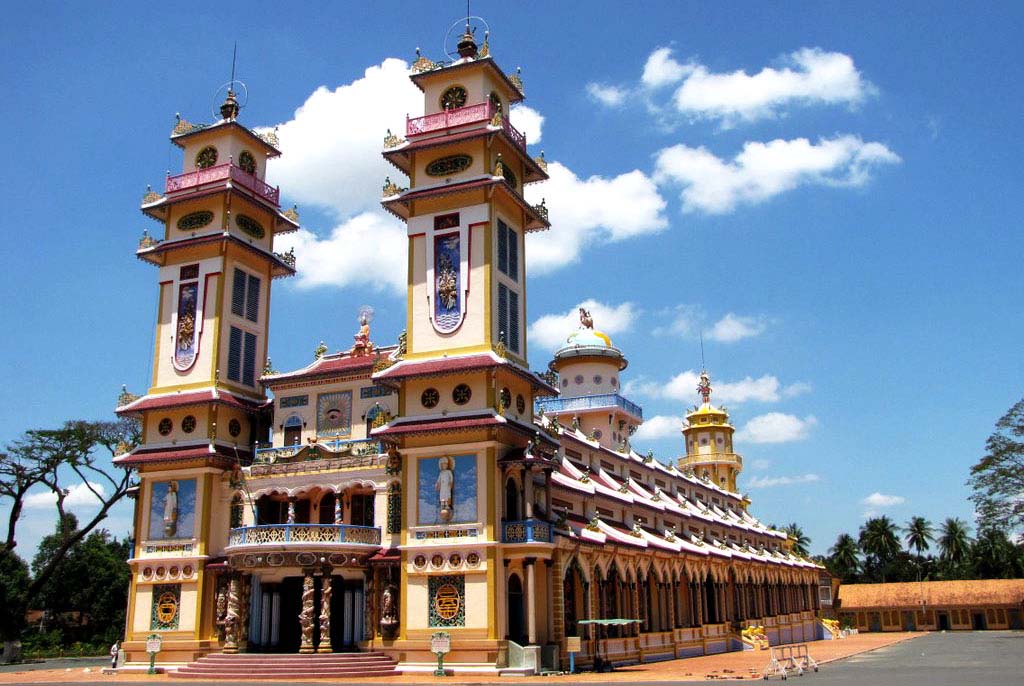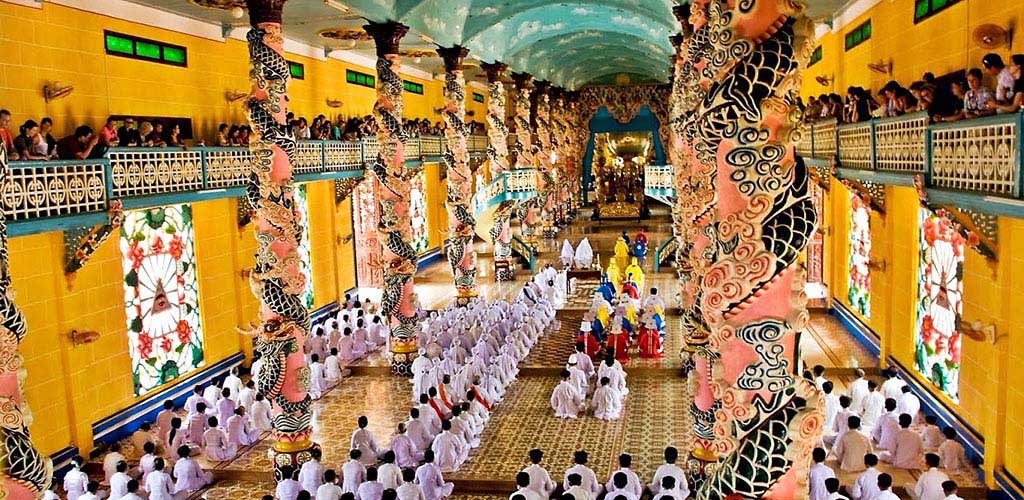Cao Dai Temple & Sect
Tay Ninh, an 90-minute drive northwest of Saigon and 30 miles from the town of Cu Chi, is a staging point for excursions to the Cao Dai Great Temple, Long Hoa Market, and Black Lady Mountain. You can reach all these sites as well as the Cu Chi Tunnels in a full-day trip from Saigon.
The main attraction is the Cao Dai Great Temple. If you have more time on your hands and want to stretch your legs, visit Black Lady Mountain (Noi Ba Den), about 15 kilometers northeast of Tay Ninh. The 900-meter peak is a sacred site, with a few cave temples perched on its flanks. It's a striking sight, as there's no major peak within a 100-kilometer radius. Caves on the mountain were used as a base by the Vietnamese fighting both the French and the United States. Walking up the mountain to the main temple complex and back again should consume a leisurely two hours; climbing to the peak and back requires about six hours.
CAO DAI GREAT TEMPLE The Temple From the outside, the Cao Dai Great Temple is already bizarre, combining the lines of a French baroque church with pagoda-like steeples. Inside you enter a realm described by Graham Greene as "a Walt Disney fantasia of the East, dragons and snakes in technicolour." Greene himself took the faith very seriously and at one point considered conversion to Cao Daism. It is perhaps odd, then, that the figure of Graham Greene has not yet found his way into the Cao Dai pantheon. One of the fascinating aspects of Cao Daism is belief in Divine Agents or patron saints-whose spirits make "contact" at seances through a temple medium using a planchette. Among the Divine Agents contacted in the past are Jesus Christ, Confucius, Lao Tzu, Moses, St. John the Baptist, Joan of Arc, William Shakespeare, Rene Descartes, La Fontaine, and Louis Pasteur. Among the leading lights contacted from the 20th century are Vladimir Lenin, Charlie Chaplin, and Winston Churchill. Greene died in 1991, so perhaps it is too early for him to be inducted into the Cao Dai hall of fame.
The three guiding spirits of the Cao Dai faith are featured in a mural in the temple vestibule: poets, prophets, and revolutionaries. The figure holding the ink stone is Sun Yatsen (instrumental in the fall of China's Manchu Dynasty); writing in French is Victor Hugo (who had a hand in starting the romantic movement in France); at the right is 15th-century Vietnamese poet Nguyen Binh Khiem, famous for his prophecies. On the other side of this wall are three statues mounted on lotus buds and raised on a three-step dais. The central figure is Ho Phap, a symbol of justice, flanked by statues of cardinals. Draped around Ho Phap is a seven-headed serpent: the top three heads symbolize love, joy, and bliss; the lower heads symbolize jealousy, anger, hatred, and uncontrollable desire. The dragon, symbolizing the force of intellect, is a dominant temple feature. Down the nave are two rows of dragon-coiled pillars supporting a lofty vaulted ceiling dotted with clouds and inlaid with flying dragons. The lotus, symbolizing purity, is another prominent motif. Piercing the walls are open lattice-work windows composed of a striking lotus design. Each lattice window encloses a Cao Dai eye set in a triangle, just like the one on the U.S. dollar bill.

THE STRANGE SECT OF CAO DAI
What do Winston Churchill, Joan of Arc, Jesus Christ, Confucius, Moses, St. John the Baptist, Charlie Chaplin, and Louis Pasteur have in common? They are all divine agents, adopted as patron saints by the Cao Dai sect. This oddball faith is a synthesis of Buddhist, Confucian, Taoist, and Christian beliefs, with a dash of Islam thrown in. Cao Daism copies its organization from the Roman Catholic Church, with cardinals, bishops, archbishops, and a pope, though there is no pope at present.
The sect was founded in the 1920s by Ngo Van Chieu, a civil servant blessed with a series of visions, including several of the Divine Eye. The messenger in the visions was Ly Tai Pe, a literary figure from the Tang dynasty, who maintained that previous revelations of the Supreme Spirit-Confucianism, Buddhism, Christianity-took place at a time when people had little contact with each other due to deficient means of transportation. As a representative of the Supreme Spirit, Ly Tai Pe announced the time had come to reorganize the world's disparate religious elements and form the Universal Religion of the Age of Improved Transport, thus achieving a harmonious whole. The Supreme Spirit was henceforth to be known as Cao Dai, symbolized by a giant eyeball.
In the 1930s and 1940s the Cao Dai sect gained a steady following, and the Great Temple — the equivalent of the Vatican — was constructed at Tay Ninh. The Cao Daists were estimated to number 1.5 million, and fielded a private army of 20,000 tolerated by the French because the sect was anti Vietminh.
In 1943 Cao Dai Pope Ngo Van Chieu died and was succeeded by Pham Cong Tac, who suffered under the French and was deported to the Comoros Islands. In 1946 he returned. In 1950 writer Norman Lewis visited Tay Ninh and glimpsed Pope Pham Cong Tac, an encounter described in his book A Dragon Apparent: His Holiness, Pope Pham-Cong-Tac, whose name means "the Sun shining from the South, "awaited us, beneath the golden parasol, attired in his uniform of Grand-Marshal of the Celestial Empire. He was carrying his Marshal'' baton, at the sight of which, according to Cao-Daist literature, all evil spirits flee in terror. Physically, the Pope looked hardly able to support the weight of his dignity. He was a tiny, insignificant figure of a man, with an air of irremediable melancholy. His presence was, in any case, overshadowed by the startling architectural details of the cathedral, for the design of which he himself had been responsible. The last Cao Dai Pope, Pham Cong Tac suffered again under the Diem regime and was forced to flee to Cambodia. Because the Cao Dai Army was incorporated into the South Vietnamese Army, and because the Cao Daists refused to support the Vietcong, the sect was disbanded after the 1975 takeover by the north. All Cao Dai lands were confiscated and the sect's leadership broken up. In 1985, however, many of the temples were returned to the Cao Daists. The sect today has several million followers in Vietnam and is particularly strong in the Mekong Delta region, where smaller temples are modeled after the Can Dai Great Temple. There are an estimated 1,000 Cao Dai temples throughout southern Vietnam.
Although it first appears a weird religion, Cao Daism follows the same basic precepts as other religions, with common goals of peace, justice, and harmony. Among its key practices are ancestor-worship, spirit contact through seances and mediums, and vegetarianism; Cao Daists believe in a cycle of reincarnation similar to that found in Buddhism. Like other religions in Vietnam, Cao Daism is restricted in its practices by a watchful government. While Cao Dai worshipers wear white, Cao Dai priests wear red, blue, or yellow robes-red symbolizes Confucianism, blue Taoism, and yellow Buddhism. Separating the inner sanctuary from the main temple are three curtains, one each in red, blue, and yellow. Suspended from the ceiling is a pediment featuring Divine Agents. There are eight small figures here-at top left is Lao Tzu, the founder of Taoism; below him the Bodhisattva Quan Am. In the middle, from top to bottom, are Sakyamuni Buddha, Ly Thai Bach (Ly Tai Pe, the spiritual Pope), Jesus Christ, and Cuong Thai Cong (a mythological figure). To the right, at the top is. Confucius; below is Quan Cong, a deified Chinese general. Smooth, tiled flooring leads up nine broad steps to the main altar. The inner sanctuary sits on an octagonal base with 12 steps, enclosed by eight dragon pillars, with a flying dragon embedded in the ceiling. In Taoism the octagon symbolizes creation and the celestial regions. An octagonal table supports a huge globe, on which is painted the all-seeing all-knowing Divine Eye, symbol of Cao Dai or the Supreme Spirit. Only high priests are allowed to approach the octagonal table during the emotionally moving service. Offerings of fruit, flowers, incense, candles, tea, and wine are made to the Divine Eye.
The Compound The Cao Dai Great Temple is set in a large compound of residences, administrative buildings, schools, and gardens. There are a few places where you can sit down for a quiet cup of tea. A short walk south of the main temple is the Temple of the Divine Mother, smaller in scale than the Cao Dai Great Temple. It is here that important figures are given last rites. Three kilometers south of the Cao Dai Great Temple is Long Hoa Market, with mostly food and poultry on sale and lively trading in progress. Conduct Scanty attire upsets the Cao Daists. Cover your arms and legs-perhaps bring some loose pants and a jacket to slip on before going into the temple. Remove shoes and hats before entering; men enter to the right, women to the left. You may walk around the temple before the service-women are supposed to walk clockwise around the temple, men counterclockwise. During the service you're restricted to the back top gallery, near the orchestra. Photography from this point is permitted — the popping of flashbulbs seems an accepted part of the ceremony and doesn't faze anyone. Getting There The Cao Dai Great Temple lies about 100 kilometers from Saigon, four kilometers east of Tay Ninh at the village of Long Hoa. Services are held daily at 0600, 1200, 1800, and midnight, and last about 45 minutes. The best plan is to arrive 30 minutes before the noon service so you can tour the entire temple and take in the service as well. Most tours permit only about an hour at the temple. If you wish to stay longer, take one tour in, a stay overnight in Tay Ninh can be arranged.
